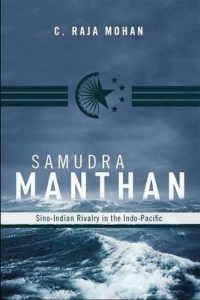
Samudra Manthan, the Sino-Indian Rivalry in the Indo-Pacific by C. Rajamohan, was published in 2012. The books main idea revolves around the Sino-Indian Rivalry in the Indo-Pacific with US as the third player in this power dynamic. This has been compared to the “churning of the ocean” to obtain the elixir of immortality.
The first chapter elaborates upon the fact that both India and China have risen to the status of important regional powers in Asia and this has prompted them to turn to the sea in order to cater to their naval power. Therefore, the author also describes the various consequences of India and China’s rise in the maritime domain. Both countries have been traditionally obsessed with land warfare and often ignored the importance of sea and ocean as a tool of international relations. However, due to globalization, both countries are forced to pay attention to their maritime interests. They have realized that their economic growth and prosperity cannot be sustained without access to energy resources and minerals. The author also clarifies the use of the term “Indo-Pacific” which has gained attention in the last few years. The term refers to the integration of regional theatres in the Eastern Hemisphere.
The second chapter deals with the structure of Sino-Indian Relations. This chapter begins with a brief review of the engagement between the two counties since the early decades of the twentieth century when continual efforts to build a partnership could not prevail over the logic of conflict. Initially, both efforts were manifested in their romanticism of “Hindi-Chini Bhai-Bhai”. However, 1962 war shattered every possibility of cooperation and trust between the two. Trade did increase between the two considerably benefitting both the countries. It focuses on the territorial disputes that have kept both countries hot-headed while dealing with each other.
The third chapter deals with the increasing attention that both India and China started giving to Seapower. Scholars in these countries made efforts to revive their glorious maritime days. The author acknowledges that although China was landlocked that is why it was natural for it to focus more on land warfare, even India which had a very diverse coastline only focused on the northwestern frontier as the major security threat. The chapter then focuses on the influence of Mayans on India and China to build powerful navies. He was the pioneer of maritime developments when the US was on the rise to become a global power. The chapter then proceeds on elaborating on how the economic liberalization of both countries has led to increased attention to maritime developments.
The fourth chapter focuses on the actions of China and India with the advent of the 21st century. Both the countries began to understand each other’s capabilities and intentions with the Gulf of Aden. The United Nations gave legitimacy to extend the naval power to deal with issues of Piracy. China which was earlier not interested in United Nations peacekeeping operations, but after the turn of the century, it began to vigorously participate in them considering itself a rising great power. This drove the Chinese intentions to begin investing abroad. On the other hand, India had been involved with United Nations since the 1950s. in India too, maritime development was considered as an extension of its foreign policy objectives.
The fifth chapter focuses on the nuclear issues that have been central to both India and China. India’s nuclear capability began to surge with an increased partnership with the US. This chapter focuses on recent significant naval nuclear developments in India and situates them in a comparative perspective in relation to China. It also describes how India’s emerging maritime nuclear capabilities might affect the Sino-Indian naval dynamic as well as other great powers, especially the United States. It evaluates the impact of Indian and Chinese maritime capabilities on the Indian Ocean and the Western Pacific.
The sixth chapter focuses on India’s pacific ambitions. With its Look East policy, India began to focus on East Asia, however, it has only progressed marginally. Although both India and East Asia have an ancient connection, due to India’s inward-looking policies after independence, their relationship didn’t flourish. India was more focused on global order and multilateralism. With the 21st century, India turned towards its integration with Asia. The chapter emphasizes the fact that India’s interests range from Aden to Malacca. It began to engage in service exchanges with regional as well as major powers. It even conducted trilateral exercises with the US and Japan. India also expanded its security cooperation with ASEAN.
The Seventh Chapter is titled “China eyes the Indian Ocean”. Initially, China’s interests have been limited to integrating Taiwan and limiting US influence in the maritime domain. But with its rising capabilities, it has turned towards the Indian Ocean. The very first appearance of the Chinese Navy in the Indian Ocean Region comes with the PLAN. This made the Indian navy conscious of increased Chinese attention. China has major interests in IOR, such as energy requirements and protection of Sea Lines of Communication. Also, the proposition that China wants to gain ground in India. However, some analysts conclude that this might be an exaggeration.
The Eight chapters elaborate on India and China’s interest in maintaining a forward presence in other nations and stationing forces overseas to demonstrate national resolve, strengthen alliances and enhance the ability to respond to contingencies. This has been evident in China’s “String Of Pearls” strategy. India has been less overt when it comes to such initiatives but gradually it has begun to focus its attention on island nations such as Sri Lanka, Mauritius and Singapore. The chapter then moves on to discuss the significance of Seychelles and Mauritius for India and China. These littoral states are strategically located and are known for their natural resources. This has resulted in constant competition between China and India to command greater influence over them.
The Ninth Chapter deals with the investigation of the Sino-Indian security dilemma in relation to the littoral states of the Indian and Pacific Oceans. The author categorically evaluates this dilemma with a competitive logic in the Arabian Sea, the Bay of Bengal, and the South China Sea.
The tenth chapter acknowledges the fact that the security dilemma between India and China needs to be mitigated. The author suggests that this security dilemma can be diminished by more peaceful policies. It elaborates on the Sino-Indian confidence-building measures and the many problems associated with it. The chapter explores the prospects for a bilateral maritime security dialogue that will act as a platform for open discussion of each other’s apprehension and finds ways to harmonize and limit their conflict between their interests in the Indo-Pacific.
The Eleventh Chapter evaluates the three possible future orders in the region i.e. cooperative security, a great-power concert, and a balance of power system. This chapter focuses on the consequences of the Sino-Indian Rivalry on the Indian-Pacific.
The final chapter titles as the book “Samudra-Manthan” deals with the triangular dynamic of India, China and the US. The author states that the consequences of Sino-Indian Rivalry on the Indo-Pacific is also influenced by the United States as it has been a leading maritime power. This has led to the emergence of a strategic triangle. The rise of China has already raised some fundamental questions for the future of the United States. Due to this, India seems to be a perfect strategic partner for the US and it tends to become more hostile towards China. So this triangle will surely emerge as a story of “twists and turns”.













